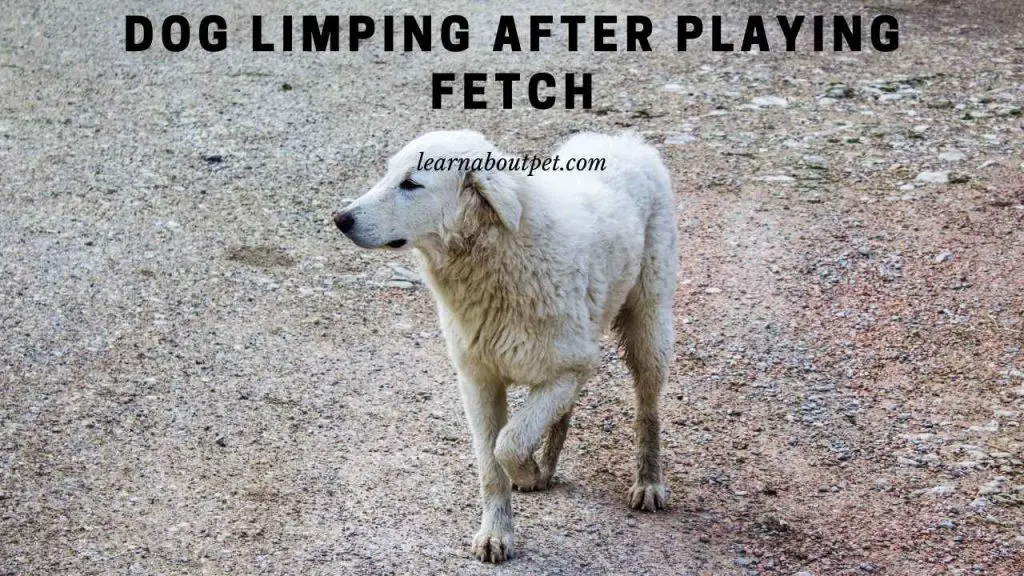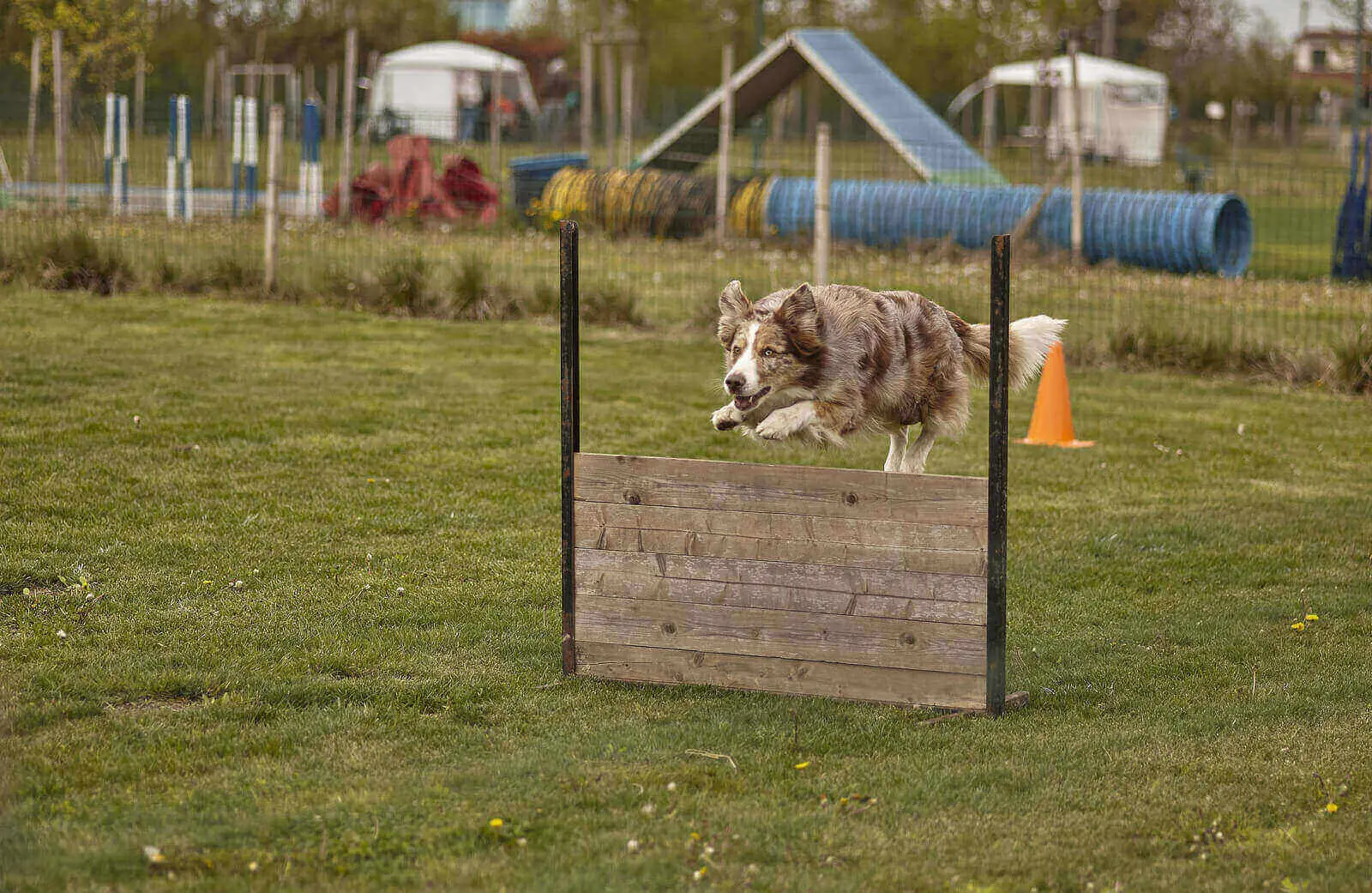There are cases in which you may observe that your dog is limping after playing fetch. Once you make this sort of observation, you will want to know whether such limping after playing fetch is normal, what causes it, and what you can do about it. You will find the answers in this article.
Possible reasons for a dog limping after playing fetch include overexertion and claw, toe or paw injuries such as strains, sprains or bone fractures.
You may need to check the severity of the limping, to figure out the reason behind it.
A case in which the dog is limping but doesn’t seem to be in pain has different implications from another one in which the dog is obviously in great pain.
Similarly a case in which the dog is limping but still running around has different implications from another one in which the apparent injury has completely grounded the dog.

It may also be necessary to think of what else the dog did, besides playing fetch.
Suppose my dog started limping after running and playing fetch. I would then attribute the limping to either the running or the fetch game: instead of laying the blame on the fetch game alone.
The nature of the limping is also a relevant consideration. Take a case in which you find the dog limping on and off. That has different implications from one in which the dog limps persistently.
But before going any further, we need to establish whether it is normal for a dog to limp after play. Then we will proceed and establish whether a dog limping after playing fetch specifically is normal.
Is It Normal For A Dog To Limp After Playing?
It is common for dogs to limp after playing. But it is certainly not normal. We can’t say that limping under any circumstances is ‘normal’.
Limping entails the dog showing a tendency to avoid bearing weight on any one of its limbs. That is usually because the dog experiences pain/discomfort when it bears weight on that limb.
Against that background, we really can’t say that it is normal for a dog to limp after playing. It is something that happens commonly. But it is not normal.
Even in a case in which my dog is limping but shows no other sign of pain, I wouldn’t view the whole thing as ‘normal’.
If a dog limps after play, it is a sign of something wrong. Granted, what may be ‘wrong’ is something as simple as overexertion. But that too can deteriorate into much worse outcomes.
Therefore we can’t really term any form of dog limping as a ‘normal’ thing. A dog limping after playing with another dog, a dog limping back leg after running, a dog limping after vet visit… none of these should be taken casually.
Even a dog limping after walk or dog limping after playing hard can’t be said to be ‘normal’ under any circumstances.
Of course, some cases of dog limping can be more worrisome than others. For instance, the case of a dog limping on and off for months can cause great concern.
It can be more worrisome than another in which the dog just started limping after playing fetch.
All in all, whereas it is common, it is certainly not ‘normal’ for a dog to be limping. Each case of limping at least warrants an investigation.
Is My Dog In Pain If He Is Limping?
Upon observing your dog limping after playing fetch, you will probably want to know whether such a dog is in pain.
The truth of the matter is that any case of a dog limping is an indication that the dog could be in some sort of pain.
Normally, what causes the dog to limp is pain. Whenever the dog bears weight on the limb with an injury, he experiences pain. That is what makes him limp in response.
Thus if, for instance, my dog is limping after running, I would interpret that as possibly a sign of being in pain. That would still be the interpretation, if my dog limps after running persistently.
Similarly, a case in which the dog started limping after playing fetch may be the sign of pain somewhere.
A dog limping after playing all day can be a sign of pain too.
But at this point, one may ask, if limping is a sign of pain, why is my dog limping but still running around? And should I be worried about my dog limping in that case?
Here, it is important to note that the pain that causes a dog to limp may not be persistent. It may be pain that only comes when the dog bears weight on the limb with an injury.
So you find that the rest of the time, the dog doesn’t experience pain. But when it bears weight on the affected limb, there is pain. So it limps to avoid such pain.
All in all, if your dog is limping, it is a sign that he could be in pain of some sort.
Is It Normal For A Dog To Limp After Playing Fetch?
A case of a dog limping after playing fetch is not normal. It may be common for dogs to limp after playing fetch. But it doesn’t qualify to be termed as ‘normal’.
If the whole thing has sudden onset, you need to ask yourself, why is my dog limping suddenly after playing fetch? Why is my dog limping all of a sudden after a game of fetch?
And if the dog has chronic limping, which a game of fetch seems to have worsened, you still need to find out why.
Don’t assume that a dog limping after playing fetch is normal.
Why Is My Dog Limping After Playing Fetch?
One possible reason for dog limping after playing fetch is overexertion. Fetch is quite a physically challenging game. Sometimes, you find that a dog limps after playing fetch for too long due to overexertion.
The other possible reason for dog limping after playing fetch is injury. Technically, even the ‘overexertion’ we made reference to still falls under the injury category.
That is because when a dog plays fetch for too long, there are small tears in various parts of its body, which then cause the limping.

Thus if my dog started limping after playing a vigorous game of fetch, I would attribute it to the exertion-induced tears.
But there are other injuries that may result more directly from a dog playing fetch.
In the course of playing fetch, the dog’s claws may get torn. Or the dog may suffer strains, sprains or bone fractures while playing fetch. All these can cause it to limp afterwards.
Thus if my dog is limping after playing fetch, these are the reasons I would be thinking in terms of.
Often, when the dog ‘lands’ after fetching the object it was required to fetch, it does the landing in an awkward manner. This often leads to injuries, which in turn cause the dog to limp.
Dog Limping After Playing Fetch – What Can I Do About It?
If the injury causing the dog to limp seems to be severe, you need to take it to the vet urgently.
Or if the dog is limping persistently for too long after playing fetch, you need to consult a vet.
Thus if you had the when should I take my dog to the vet for limping question, those are the possible answers to it. That is when the limping (after playing fetch in this case) is either too severe, or too persistent.
But there are cases in which the limping doesn’t seem to be too severe. This may lead to questions like the one on what to do if your dog is limping but not crying.
There are cases in which all you need to do is allow the dog to rest. Restrict its movements, to promote faster healing.
In fact, when you research on how to treat a limping dog after playing fetch at home, you see that most resources recommend ‘rest’ as treatment.
Some sorts of (open) injuries may benefit from proper cleaning, and application of ointment too.
But anything that seems to be very severe or is too persistent, in terms of limping, requires veterinary attention.
There are also cases in which it may be worthwhile to reconsider exposing the dog to games such as fetch.
For instance, if my dog loves to play fetch but most of the time limps afterwards, I would consider barring him from that sort of game. It may just be a bad fit for him, given his bodily constitution.
Ultimately, if you had the what to do if my dog started limping after playing fetch question, the answer is along these lines.
How Long Does A Dog Limping After Playing Fetch Take To Heal?
Once you observe your dog limping after playing fetch, one of the key questions you are likely to have is on how long it may take to heal.
So, indeed, how long does it take for a dog to recover from limping? In some cases, it can be as little as two days. For instance, if the dog is limping simply due to overexertion, two days may be enough for recovery.
But it can also take as much as two weeks (or even longer) for a dog limping after playing fetch to recover.
Take a case in which the injury is due to a major sprain injury, such as anterior cruciate ligament tear. The vet’s treatment here may entail a surgery. And the dog may require as much as 2+ weeks to recover after the surgery.
The age of the dog also matters. A puppy limping after playing fetch may recover faster than a senior/aging dog in the same predicament.
Final Verdict – Dog Limping After Playing Fetch
It often happens that some dogs limp after playing fetch. It is not normal, but it is a common occurrence.
The limping after playing fetch can simply be due to overexertion (and the minor tears that such overexertion causes).

A dog’s limping after playing fetch can also be due to other injures, including strains, sprains and fractures.
Sometimes, all you need to do is allow the dog that is limping after playing fetch to rest. Strictly restricting its movements for a few days is at times all it takes to have it recover naturally.
There are also cases in which cleaning the dog’s injuries and applying ointment can be helpful. This is especially the case for small open/external injuries.
Severer or more persistent cases in which dogs limp after playing fetch always call for proper veterinary attention.
As a pet lover, make sure to learn about pet more and give your pet dog a good and comfortable life!

Welcome to Learn About Pet. My name is Rajkumar Ravichandran and I love all pets, travel, and amazing food. I write about my passion and personal experience caring for multiple pets in this blog! ❤️
Post Disclaimer
DISCLAIMER: THIS BLOG OR WEBSITE, "Learn About Pet", DOES NOT PROVIDE YOU WITH MEDICAL ADVICE AND IS NOT A SUBSTITUTE FOR MEDICAL ADVICE. ALWAYS GET IN TOUCH WITH YOUR PERSONAL VETERINARIAN AND USE INFORMATION HERE AS GENERAL ADVICE.
The information, including but not limited to, text, graphics, images and other material contained on this website are for informational purposes only. No material on this site is intended to be a substitute for professional veterinary advice, food recommendation, diagnosis, or treatment. Always seek the advice of your veterinarian or other qualified health care provider with any questions you may have regarding a medical condition or for pet food related questions.







